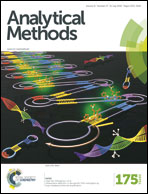Determination of ascorbic acid in the retina during chicken embryo development using high performance liquid chromatography and UV detection
Abstract
The retina is a specialized tissue of the central nervous system (CNS) and it is the only part of the CNS that can be visualized non-invasively. During vertebrate development, the retina originates together with the optic nerve as outgrowths of the developing brain, and in this respect, the avian retina is a very convenient model for neurochemical studies of the CNS. In this study, a HPLC-UV method was developed and validated for the determination of ascorbic acid (AA) in the chicken embryo retina. AA has an important role in the retina because of its antioxidant properties. The developed method showed very good figures of merit (recovery = 91 ± 2%; repeatability and intermediate precision better than 1.67% and 2.53% and a limit of quantification of 0.03 mg L−1). Retinas of two embryo ages (12 days and 18 days) showed AA concentrations of 0.0107 ± 0.0010 and 0.0055 ± 0.0005 μg of AA per μg of protein, respectively, and the statistical comparison of results confirmed the decrease of the AA level. These results seem to correlate well with oxidative stress protection, but this fact is still under investigation. As far as we are aware, this is the first study that demonstrates the HPLC-UV determination of ascorbic acid in the chicken embryo retina and its variation along embryo development.


 Please wait while we load your content...
Please wait while we load your content...